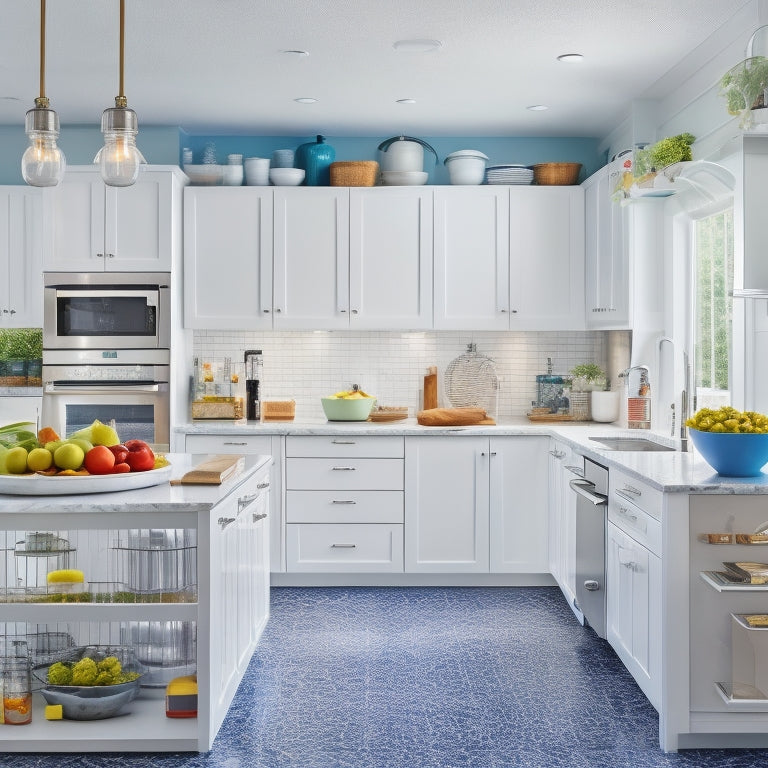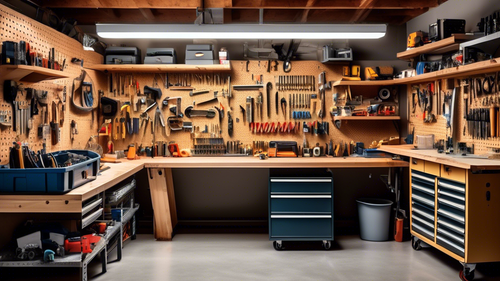
Label Your Way to a Clutter-Free Kitchen
Share
You're feeling overwhelmed by your cluttered kitchen, but it's time to take control. Identify the trouble spots, like your pantry and countertops, and pinpoint specific challenges, such as lack of organizing tools. Then, create a plan of action and utilize labels to clear mental clutter and streamline storage. Labels will help you identify hidden patterns in your cooking habits, create tailored kitchen organization, and simplify daily tasks. As you start labeling, you'll uncover opportunities to refine your systems and habits, leading to a more efficient and organized kitchen. Now, discover how to create a labeling system that works for you.
Key Takeaways
• Labels help identify hidden patterns in cooking habits, allowing for tailored kitchen organization and reduced clutter.
• Assigning a home to each item with a label clears mental clutter, simplifies daily tasks, and creates a sense of order and structure.
• Maximizing storage potential with labels and visually labeled baskets saves time, reduces frustration, and enhances inventory management.
• Labeling small kitchen items, such as spice jars and utensil drawers, makes a significant efficiency difference and saves time.
• Maintaining labeled kitchen spaces through regular schedules and tasks ensures smooth kitchen operation and prevents clutter buildup.
Identifying Kitchen Organization Challenges
To get started on your journey to a clutter-free kitchen, take a step back and assess the spaces that overwhelm you, from the jam-packed pantry to the countertops cluttered with appliances and gadgets.
Identify the areas that make you feel stressed and frustrated. Is it the narrow kitchen layout that makes it difficult to move around? Or the lack of organizing tools that forces you to search through drawers to find what you need?
Take note of the specific challenges you face in your kitchen. Do you struggle to find space for your cookbooks, or do you have a hard time keeping your countertops clear? Are there certain tasks, like meal prep or cooking, that feel more challenging due to the clutter?
By acknowledging these challenges, you'll be able to pinpoint the solutions that will make the most impact. This will help you create a clear plan of action to tackle your kitchen organization project.
With a clear understanding of your challenges, you'll be able to create a kitchen layout that works for you, and utilize organizing tools that streamline your workflow.
The Power of Labels in Organization
As you start labeling your kitchen, you'll notice that it's not just about slapping stickers on containers - it's about creating a system that clears mental clutter, streamlines storage spaces, and helps you identify hidden patterns in your cooking habits.
By doing so, you'll gain clarity on what you need, what you can get rid of, and how to optimize your kitchen's workflow.
With labels, you'll be able to create a kitchen that's tailored to your unique needs and cooking style.
Clearing Mental Clutter
You'll be surprised at how much mental clutter you can clear simply by assigning a home to each item and labeling it, allowing you to focus on more important tasks.
By implementing mental decluttering techniques, you'll simplify daily tasks and break free from the mental blocks that hold you back.
A cluttered kitchen can be overwhelming, making it difficult to think clearly and make decisions. By labeling your kitchen items, you'll create a sense of order and structure, clearing mental space for more important things.
Mindful organization is key to clearing mental clutter. When you know exactly where everything is, you'll feel more in control and confident. You'll no longer waste time searching for misplaced items or worrying about what's for dinner.
With a clear and organized kitchen, you'll be able to tackle tasks with ease and precision, freeing up mental energy for more creative pursuits. By labeling your way to a clutter-free kitchen, you'll reveal a sense of calm and clarity, giving you the power to take on anything that comes your way.
Streamlining Storage Spaces
By maximizing the potential of your storage spaces with labels, every item in your kitchen finds a designated spot, making it easy to find what you need when you need it. This is especially true when it comes to basket organization. By visually labeling each basket, you can see at a glance what's inside, eliminating the need to dig through multiple containers to find what you're looking for. This not only saves time but also reduces frustration.
In your pantry, clear labeling takes inventory management to the next level. By labeling each shelf and category, you can quickly identify what you have and what you need to restock. This helps you avoid buying duplicates and reduces food waste.
With a well-organized pantry, meal planning becomes a breeze, and you'll be more likely to cook at home, saving you money and time. By streamlining your storage spaces, you'll be amazed at how much more efficient and productive you'll become in the kitchen.
Identifying Hidden Patterns
Your labeled storage spaces now serve as a foundation for uncovering hidden patterns in your kitchen organization, revealing opportunities to refine your systems and habits.
By analyzing your color-coded labels, you're able to identify which items are used most frequently and which ones are collecting dust. This insight allows you to optimize your spatial layout, placing frequently used items in easy-to-reach locations and storing less-used items in harder-to-reach areas.
As you recognize item frequency, you'll start to understand usage patterns. You might realize that you're using certain cookware or utensils more often during specific meals or times of the day. This knowledge enables you to adjust your storage and workflow to accommodate these patterns, streamlining your cooking process and reducing clutter.
Creating a Labeling System
Establish a consistent labeling system that makes sense to you, and stick to it, to guarantee that every item in your kitchen has a designated home. This will help you maintain a clutter-free kitchen and make the most of your organizational efforts.
Consider using color-coded labels to categorize items into groups, such as baking supplies, cooking utensils, and pantry staples. This visual system will provide instant organizational benefits, allowing you to quickly locate what you need.
But don't stop there! Take your labeling system to the next level by incorporating personalized tags that reflect your unique needs and preferences. For example, you might label a specific shelf for 'Breakfast Essentials' or create a tag that says 'Snack Attack' for your favorite treats.
These creative solutions won't only make your kitchen more functional but also more enjoyable to be in. By creating a labeling system that's tailored to your lifestyle, you'll be more motivated to maintain your kitchen's organization and keep clutter at bay.
Labeling Storage Containers Effectively
When it comes to labeling storage containers, you're not just slapping on a sticker - you're creating a system that'll make your kitchen run smoothly.
To get the most out of your labels, you'll want to follow some key tips to guarantee they're clear, concise, and easy to read.
Container Labeling Tips
Tackle the chaos in your kitchen by labeling storage containers effectively, guaranteeing you can swiftly identify what's inside and where it belongs. One common labeling mistake is using vague labels like 'Miscellaneous' or 'Snacks.' Instead, opt for specific labels that clearly state the contents, such as 'Aluminum Foil' or 'Granola Bars.' This will save you time and frustration when searching for a particular item.
To avoid labeling mistakes, take the time to organize your containers before labeling them. This will help you categorize similar items together and confirm that each label is accurate.
For creative container labels, try using DIY ideas like washi tape, chalkboard labels, or even painting the labels directly onto the container. You can also add a personal touch by using colorful markers or stickers to make your labels more visually appealing.
Labeling for Visibility
You'll maximize the effectiveness of your labeling system by positioning labels in a way that makes them easily readable, even when containers are stacked or stored in hard-to-reach areas. This is pivotal for labeling for efficiency, as it allows you to quickly identify what's inside without having to dig through multiple containers.
To improve visibility, consider the following label placement strategies:
| Label Placement | Benefits |
|---|---|
| Top and Side | Easy to read when containers are stacked |
| Front and Center | Simple to identify contents from a distance |
| Edge of Shelf | Labels are visible even when containers are pushed back |
| Color-Coding | Quickly distinguish between similar containers |
Designating Zones in the Kitchen
By dividing your kitchen into distinct sectors, you're able to efficiently allocate tasks and create a more organized cooking environment. Sector organization is key to maximizing your kitchen's potential and minimizing clutter. By designating specific areas for tasks such as food preparation, cooking, and cleaning, you can streamline your workflow and reduce stress.
Labeling these sectors is essential to maintaining this organization. Labels help you quickly identify where items belong, making it easier to put things back in their place. This, in turn, prevents clutter from building up in the first instance.
With clear labels, you can also guarantee that everyone in the household knows where items are stored, reducing confusion and frustration.
Maximizing Cabinet Space With Labels
As you assign labels to your cabinets, you're able to reveal the full potential of your kitchen's storage capacity.
By categorizing and labeling your cabinet contents, you'll be amazed at how much more space you can maximize.
Start by labeling spices, grouping similar items together, and storing them in a designated cabinet or on a spice rack. This will free up valuable real estate in your pantry for more essential items.
Speaking of your pantry, organizing it's a breeze when you label essentials like canned goods, baking supplies, and snacks. Use clear and descriptive labels, so you can quickly identify what's inside each container or shelf.
By doing so, you'll be able to find what you need in a flash, and avoid clutter from building up in the future.
With labeled cabinets, you'll be able to maintain a sense of order and control, making meal prep and cooking a whole lot easier.
Streamlining Kitchen Drawer Organization
Your kitchen drawers, often the most cluttered and chaotic areas of the kitchen, can now be transformed into efficient storage spaces with a few simple labeling strategies. By implementing drawer dividers, you can separate items into categories, making it easier to find what you need when you need it.
For instance, designate a section for utensils, another for cookware, and another for storage containers. This segregation will prevent clutter from building up in the future.
To take your organization to the next level, incorporate color-coded labels into your system. Assign a specific color to each category, and use labels with that color to identify the contents of each section. This visual cue will help you quickly identify where items are stored, saving you time and reducing frustration.
Labeling Small Kitchen Items Efficiently
You're now ready to tackle the often-overlooked task of labeling small kitchen items, which can make a significant difference in the overall efficiency of your kitchen.
Start by labeling your spice jars, ensuring you can quickly identify the contents. Use a label maker to print out clear, readable labels, and consider categorizing spices by type or frequency of use.
Next, turn your attention to pantry items, such as cans, jars, and bags. Labeling these items will help you keep track of expiration dates and contents, making meal planning and grocery shopping a breeze.
Don't forget to organize your utensil drawers and pots and pans. Label each drawer or section to designate specific utensils or cookware, keeping similar items together. This will save you time searching for the right tool or pot, and prevent clutter from building up again.
Maintaining Your Labeled Kitchen
Now that your kitchen is labeled, set aside a few minutes each week to maintain this new system, ensuring it continues to boost your productivity and reduce clutter. This will help you stay on top of organization and keep your kitchen running smoothly.
Label Maintenance Schedule
| Day | Task | Frequency |
|---|---|---|
| Monday | Check expiration dates | Weekly |
| Wednesday | Wipe down labels | Bi-Weekly |
| Friday | Restock labeled containers | As needed |
| Sunday | Review label organization | Monthly |
Frequently Asked Questions
Can I Use Handwritten Labels or Do I Need a Label Maker?
As you hold the pen, your thoughts are the brushstrokes on the canvas of organization. You're wondering, can you rely on handwritten labels or is a label maker the masterstroke?
How Do I Keep Labels From Peeling off Over Time?
To keep labels from peeling off, you'll want to guarantee they're durable and well-maintained. Apply labels to clean surfaces, avoid exposing them to moisture, and replace them promptly when worn to prevent label wear and extend their lifespan.
Are There Specific Label Sizes for Different Storage Containers?
As you navigate the labeling landscape, you'll find that label size is like a key that opens the perfect fit for your storage containers - from petite jars to large bins, choosing the right size guarantees a harmonious union.
Can I Use Labels on Items That Are Exposed to Heat or Moisture?
When using labels on items exposed to heat or moisture, you'll want to guarantee label durability. Look for labels with heat-resistance and waterproof coatings. Regularly inspect and clean labels to maintain their adhesion and readability, making label maintenance a breeze.
How Often Should I Review and Update My Labeling System?
You should regularly review and update your labeling system, ideally every 3-6 months, to make sure it remains effective and organized, adjusting your strategy as needed to maintain peak label maintenance and frequency.
Related Posts
-

Organize Your Garage Workbench
Organize Your Garage Workbench: A Comprehensive Guide Is your garage a disorganized mess, with tools scattered eve...
-

Clear Digital Clutter for a Peaceful Mind
You're tired of feeling anxious and mentally fatigued, but do you know that your cluttered digital space is a major c...
-

Effortless Kitchen Gadget Storage Solutions
You're about to convert your kitchen into a haven of organization and efficiency with effortless gadget storage solut...


